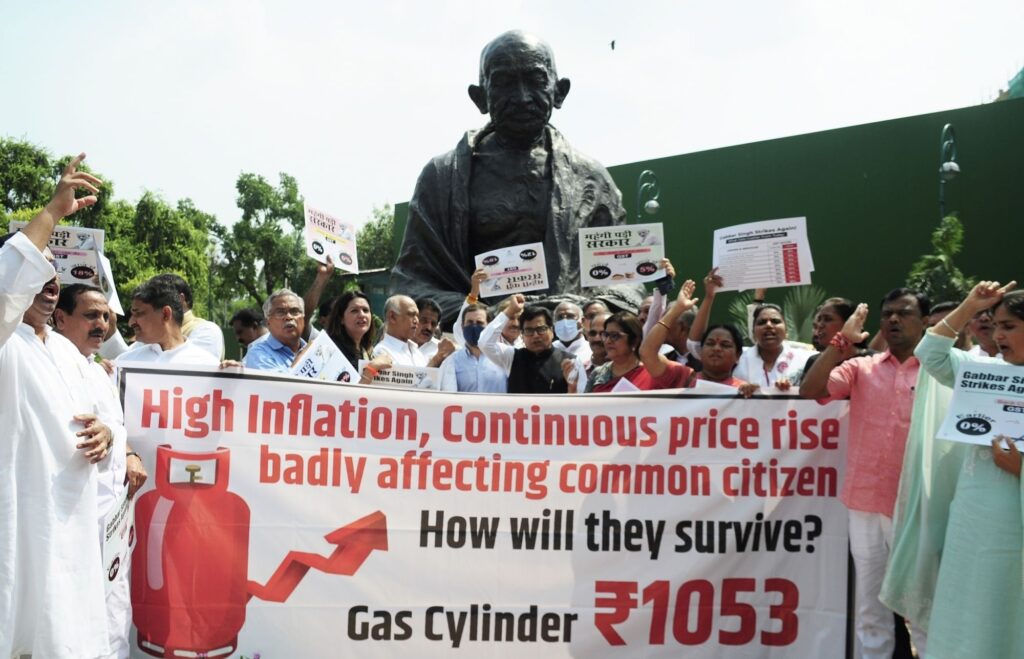The BJP government was enthusiastic to adorn the 75th year of independence with a high-sounding name. Because of that, the people of India are forced to read and hear the term ‘Amritvarsh’ every day. The word suggests a year in which life would be victorious over death.
But as it happens with every ceremonious name or scheme coined by the BJP, ‘Amritvarsh’ is also heading in the opposite direction, where death stares at life fiercely. ‘Amritvarsh’ of India is characterised by unprecedented price hike on all the necessities of life. The people of India find it increasingly difficult to cope up with the shooting prices and their diminishing income.
This ‘Amritkaal’ is meant only for exploiters. The dreams of common man to live a decent life has turned into ashes, thanks to the wildfire of price rise. In the year of ‘Amritvarsh’, the price of daily commodities is higher than that of the previous year.
While one litre of packaged milk used to cost Rs 56, this April it cost Rs 60. The rise in prices of vegetables last year was around Rs 80-100 for a kg; this year it costs Rs 100-120 for the same. The price of edible oil has doubled; a litre which earlier cost Rs 80-100 now costs Rs 200-220 this April.
A domestic LPG cylinder used to cost Rs 450 two years ago for the common family, with government subsidy. Now, thanks to Modi government’s ‘masterstroke’ to remove subsidies, it costs a staggering Rs 1050. Fuel prices face a strange fate in the country, wherein they decline in the run-up to elections being held anywhere in the country and increase afterwards while being controlled by ‘market forces.
’Indeed, the only thing that has remained stagnant is the income and suffering of the masses and the apathy of the government. The Centre’s recent GST restructuring too has come as a heavy blow for the common man. Taxes were hiked not against luxury goods but against the day-to-day essentials of a common man’s family.
Items such as curd and paneer, which were previously exempted from GST, will now attract five percent GST. Even daily staples such as wheat, rice and flour are not free from GST. Hospital rooms, which remain as a constant reminder of the failure of the Modi government during the deadly second wave of the Covid pandemic, too will now attract GST.
It all makes one wonder what the Modi government really intends by raising taxes on commodities that affect the poorest the most, all amidst a global supply chain crisis!Incumbent Union Finance Minister Nirmala Sitharaman, the architect of the GST exercise, has come out with her own justifications for this. But such a futile exercise will not salvage the Indian economy, which is already on a downward slide. Sitharaman may be devotionally striving to become a committed exponent of ‘Modinomics’, but ‘Amritvarsh’ is marked by gloom and doom for the common man.
Data coming from all sides portrays this doom. As per the latest NFHS Survey conducted by the Ministry of Health and Family Welfare, 36 per cent of Indian children are stunted (too short for their age), 67 per cent of children suffer from some extent of anaemia, and even 57 per cent of women and 25 per cent of men suffer from anaemia. It also found that 35 out of every 1,000 children born in India do not live to celebrate their first birthday.
A recent study published by PLOS Global Public Health reports that 70 per cent of the districts in India fail to meet Maternal Mortality Rate (mothers dying due to pregnancy related complications) target set by the United Nations. The Global Health Index 2021 ranked India 101 out of 116 countries, with 25 lakh Indians dying of hunger, with the nation earning the classification of ‘serious’. As per the government’s State of Inequality Report, the top 10 per cent of the country’s population earns merely Rs 25,000 a month.
One can well imagine the state of those in the other side of the table. Adding to all this is the declining value of the Rupee, which fell to 80 against one US Dollar. State Bank of India’s chairperson, while admitting that this would cause ‘short-term pains’, has said: “It (further fall in the rupee) is required, otherwise exports will become absolutely unviable.
It is important to maintain parity. It can be achieved only if the rupee is allowed to depreciate further. ”His words are a warning signal for the salaried people and the downtrodden that their lives are going to be get even more miserable.
The government says India must learn lessons from neighbouring Sri Lanka. True, there are lessons for India from Sri Lanka, but only for the government, not for the people. It is important for the government to learn that divisive politics might give it temporary electoral relief, but only real development with people-friendly policies can save any nation from disaster.
(IPA Service)Views are personalOpposition leaders protest against rising prices of commodities, LPG price hike inside Parliament premise.
From: nationalheraldindia
URL: https://www.nationalheraldindia.com/india/modi-govts-amritvarsh-characterised-by-unprecedented-price-hike-on-all-necessities-of-life
